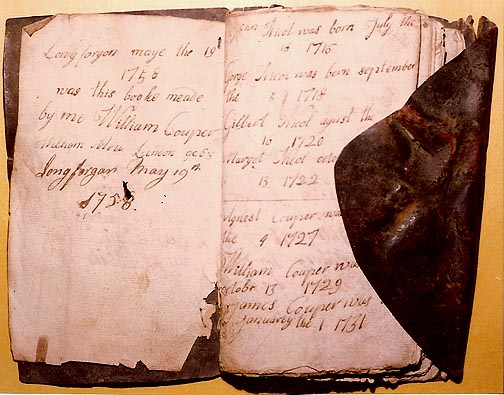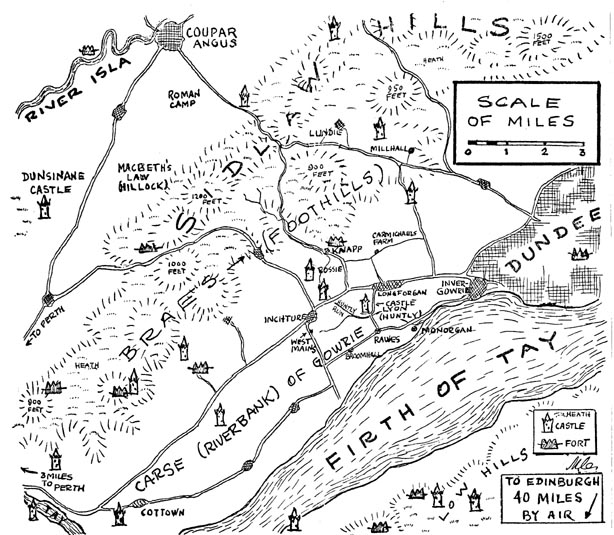|
THE LEATHER-BOUND
BOOK
William Couper II Accounts, 1758-1782
William Couper III (1775-1855) brought with him to America a small
Leather Bound Book that was written by his father in Longforgan,
Scotland.
This was later analyzed by Monroe Couper, in 1976, and the transcript is
located below
The book was an account of renting land around Castle Huntley (then
Castle Lyon), growing flax, weaving it into linen, and the 8 children that
were born in Scotland. It was begun in 1758 by William Couper II
(1729-1811) father of the immigrant. An earlier son also named William
died very young, so William III, the immigrant, was given the same name. |
 |
|
In
May 1758, William Couper II, of the Rawes (Row Houses) of Castle
Lyon, in the parish of Forgan and Shire of Perth, Scotland, made himself
an account book from seven sheets of legal paper (watermarked with the
Royal Arms), a covering of leather and some string. The sheets measured
six by eight inches. Stacked and folded at the middle, they gave 14
leaves or 28 unnumbered pages. He wrapped the leather around them with
a flap to hold the book closed. The final size was 6 ½ inches high and
4 ¼ inches across. Inside, William noted who had made the book, the
date and the name of his village, Longforgan.
The occasion, we can
surmise, was that he was going into an enterprise on his own. His
father, now in his sixties, was a weaver of flax. Linen had been an
important Scottish product for centuries. Thirty years earlier, a colony
of Protestant French people had been brought to Edinburgh to teach the
spinning and weaving of cambric. Even before that, his father had
married the widow of a weaver who had died in his prime. It was the
continuation of that weaver's business, already established in 1718, and
extended by William's father and mother, that he was recording in his
new book that Spring, when he listed for the year 1758 the workers
supplying the flax (lint) which was the raw material.
Perhaps, at 28,
William younger had acquired the experience and judgment his parents
thought necessary for him to assume the responsibility. More probably,
his mother was failing seriously or had died. Her death would have ended
the lease on the farmland where they grew their own flax as well as
food. This lease or tack, which we still have, had assigned the lands
and houses to John Nucoll (or Nicol) and his spouse "all the days of the
Lifetym of the longest liver of them two." Isobel, the Spouse, had
survived John Nucoll to marry William Couper and to become the mother of
William younger. He would now be the logical new tacksman in the
family.
In any event, in
the second Spring after he had started his book, i.e., in 1760, William
younger contracted to occupy land and buildings from the Countess of
Strathmore, proprietress of Castle Lyon. He would gain entry to the
yards at Easter; the house and grass at Whitsun, 7 weeks later; and the
arable lands at harvest. Then at Martinmas, November 11, with all in
readiness, William married Isobel Deuchars. As the new family started
and grew, William's book recorded the events. He skipped over to page 12
to enter births. The intervening pages filled up with business records.
Page 12 became filled with birth of the fourth child, and flax listings
had already passed this page, But William had had the foresight to
reserve page 11 for the last four children.
After 1771 he
probably started some other form of bookkeeping, partly because the book
was filling up. In 1763 he had begun a list of crop rotations on p. 26
and had to continue it on p. 25. About the same time he chose p. 20 to
list tailoring expenses, and 15 years later he put more on the final p.
28. And so, over the final ten years until 1782, he filled the remaining
blanks in the book wherever he found them and whenever he thought it
prudent to have a record: rent, funeral expense, blacksmith contracts, a
prayer, lime hauling, even a grocery list. Occasionally the children got
hold of the book, sneaking in some entries of their own.
The little volume
is in surprisingly good condition now in 1976, after more than 200
years. Though the pages are yellowing and the ink pale in some places,
most of the writing is still strong and bold, the string tenacious
though partially replaced a century ago, the cover still tough and
snappy and the spelling constantly fresh with vigorous surprises. In studying,
researching and more or less living with this book for the past few
years, I have come to feel myself a kind of foster member of the family
at that time: With a little empathy you can share some of the
ruggedness, where
Wm. Sr. in
his seventies was still turning out his four bushels of yarn a year,
added to by the many relatives and neighbors from Longforgan and other
villages. The farming could only have been grueling and one has only to read the
exacting detail of the leases to grasp how much labor as well as crop
had to be promised to the Castle personages at this time when the
residues of serfdom, though waning, had not quite been eliminated from
Scottish agriculture. Only four of the Coupers' eight children lived to
maturity [this accounts for more than one William]. From the letters of
one of them, the William who came to America (in 1801, bd 1775-1855), we
learn his opinion that, had he stayed home, he could never have become
independent, no matter how hard he had worked. But on the brighter
side, there were high energy and specific evidences of persistent
industry, system and planning, as well as family affection and loyalty.
William younger, author of the book, wanted his son William back from
America. The latter never quite got over his longing for home, although
he knew he could never go back. He rejoiced with every family contact.
When his father died, he gave his share of the inheritance to his
struggling brother John, in Scotland, which he said needed it more than
he did. And there was accomplishment. One son of William younger not
only continued the weaving trade but became a doctor as well. Among the
grandchildren in Scotland were manufacturers and professional people.
The little leather
book gives us a glimpse of our family (this one small branch of it)
making the transition from the last bit of serfdom into private
enterprise, probably before serious impact from the industrial
revolution.

Monroe Couper, Hockessin, Delaware, January 1976
 |
A Broad View of
William Couper's Business
Excerpts from
History of the Modern World by R: R. Pa1mer and Joel Colton
In the fifteenth
century Englishmen began to develop the processing of wool in England.
To avoid the restrictive practices of the towns and gilds, they "put
out" the work to people in the country, providing them with looms and
other equipment, of which they generally retained ownership. This
domestic system of rural household industry remained typical until the
introduction of factories in the late 18th century.
It was clearly
capitalistic. On the one hand were the workers, employed as needed,
receiving wages for what they did. Living both by agriculture and
cottage industry, they formed an expansible labor force, available when
needed, living, by farming when times were bad On the other hand, the
manager purchased the needed materials, passed out fiber to be spun,
yarn to be woven or dyed, paying wages for services rendered and keeping
the coordination of the enterprise in his head.
An English estimate
in 1739
held that 44¼ million persons "engaged
in manufactures" in the British Isles, This would comprise almost half
the entire population, including women and children, working-
characteristically in their own cottages under the domestic system.
Half were in the marking of woolens, others in copper, iron, lead, tin
wares, leather and smaller trades were paper, glass, porcelain, silk and
linen. Smallest of all was cotton, with 100,000 workers.
Great Britain had no
internal tariffs, insignificant gilds, no monopolies (except to
inventors) and was the largest internal free trade area in Europe.
Economic activity was largely domestic, between town and town, or region
and region. So William's business can be assumed to be of the above type
since this accounts for the records on the several types of flax/linen
products, and the varied and fluctuating list of workers. But
William remained a small operator, contributing his own and his family's
labor and running his farm.
Return To HOME
Page
|